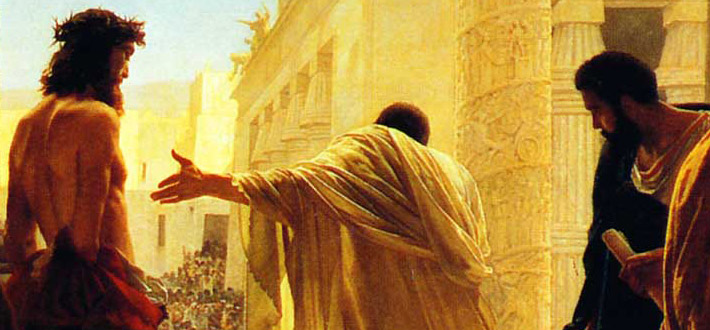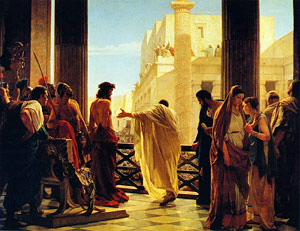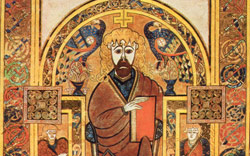
Jesus: Origins of Christianity:
Best Known Gospels
It is important to remember that the vast majority of the audiences at the time were illiterate and used to an oral tradition where stories, like the tales of Homer, were retold, shaped and re-shaped for specific audiences in a way that suited local circumstances, concerns, and beliefs. We would thus expect the “Good News” or Gospels of the life and death of Jesus to be similarly crafted.
About 58 years after the crucifixion, the sect of the Nazarenes (Acts 24.5), as the Jewish followers of Jesus were called, was expelled from the synagogue. The ex-Jewish Christian community and other Gentile Christian communities initiated by Paul then developed independently and their numbers grew. Unlike at the present time, there was hardly any interaction between the different groups. Their beliefs and practices were often very different from one another and a good number of gospels, letters and narratives circulated.
Not until the early fourth century were the 27 books now included in the New Testament first declared by the 300 bishops at the Council of Nicaea in 325 CE as being “God-breathed.” Just over a century later, in 431 CE, the third Ecumenical Council of Ephesus declared “it is unlawful for any man to bring forward, or to write, or to compose a different faith as a rival to that established by the holy Fathers assembled with the Holy Ghost in Nicaea.”
Those 27 New Testament books along with the 39 books of the Old Testament make up the 66 books of the Holy Bible of today.
Not until the early fourth century were the 27 books now included in the New Testament first declared by the 300 bishops at the Council of Nicaea in 325 CE as being “God-breathed.”
The earliest books in the New Testament are the letters of Paul, composed in the 50s—two decades after the crucifixion. Scholars date the first Gospel as Mark written around 70 CE at least 35 years after Jesus’s death, then Mathew and Luke which were composed independently from one another in the 80s or 90s. Many of the narratives they each contain were sourced from Mark hence the three are referred to as the synoptic Gospels, and they share some aspects, mostly sayings, not found in Mark but in common with each other—from which some scholars conclude a missing gospel known as “Q” was assembled in the 40s or 50s.
In spite of their names, the authors were anonymous, and make no claim that they are writing literal eyewitness accounts or building on eyewitness testimony. What we would today view as plagiarism was perfectly acceptable at the time: stories were told, retold, embellished and absorbed into existing ones, and new ones added. The writer or speaker was seen as honoring the tradition and the original text by copying it, or retelling it, importing or adding to it. Since the vast majority of the audiences at the time were illiterate, they were used to an oral tradition where stories, like the tales of Homer, were retold, shaped for specific audiences in a way that suited local circumstances, concerns, and beliefs. We would thus expect the “Good News” or Gospels of the life and death of Jesus to be similarly crafted.
Stories were told, retold, embellished and absorbed into existing ones, and new ones added.
Mark was probably written to strengthen the faith of the early Greek Christians in the face of persecution. “Its themes of travel, conflict with supernatural foes, suffering, and secrecy resonate with Homer’s Odyssey and Greek romantic novels. Its focus on the character, identity, and death of a single individual reminds one of ancient biographies. Its dialogues, tragic outcome, and peculiar ending call to mind Greek drama. Some have suggested that the author created a new, mixed genre for narrating the life and death of Jesus,” says New Testament scholar Dennis R. MacDonald in “Early Christian Literature,” an article included in The Oxford Study Bible—Revised English Bible with the Apocrypha.
Matthew’s Gospel is primarily for a Jewish-Christian audience and his story echoes the most well-known stories of the Hebrew Bible, for example: the birth of Moses when the Pharaoh orders that all children be killed, yet the infant Moses escapes. Matthew weaves a contemporary—unsubstantiated elsewhere—account of infanticide by Herod the Great and this time the infant Jesus escapes. Matthew’s “good news” is that Jesus is the new Moses and the real King of the Jews, not Herod who had been given the official title of “King of the Jews” by their Roman oppressors.
Luke is writing for gentiles in the Greek cities of Asia Minor and Greece itself, so his text is much more antagonistic towards the Jews. In his tale the birth of Jesus is announced to two groups: the shepherds and the three magi or Persian wise men, who would certainly have been Zoroastrians.
While their stories are clearly linked, only Matthew and Luke tell of the nativity of Jesus—though both versions differ considerably from each other. Mark tells nothing about Jesus’s early life at all. Scholars believe these birth stories were added as an introductory supplement to the rest and each for a different audience. “To attempt a full reconciliation of the two Infancy Gospels is a patently lost cause: squaring the circle would be easier than reducing the two into a single coherent unity.” —Géza Vermès, The Nativity

The last Gospel included in the New Testament is John. It is very different in style and was written later than the other three, around 85–110 CE. As Bart Ehrman says, “If you read the gospel of John, you don’t read who Jesus said he was you read who John said he was. Jesus understands himself to be God and calls himself Divine in the Gospel of John, but only in the Gospel of John, not in the Synoptic (earliest) gospels.”
“Jesus understands himself to be God and calls himself Divine in the Gospel of John, but only in the Gospel of John, not in the Synoptic (earliest) gospels.”
Although in the past attributed to the disciple John Zebedee, scholars now think that at least three authors wrote John over a period of 25 to 30 years, and none of them was an apostle. Once again, it’s important to consider what was going on over this period. Roman oppression of the Jews had been ceaseless since the destruction of Jerusalem in 70 CE, including the persecution of the Jewish disciples of Jesus who had formed a movement within the synagogue. For more than sixty years these followers had waited for their Messiah to return and establish the Kingdom of God. As new generations entered the fold, they had wanted to include Jesus as a prophet in the Jewish faith just as Isaiah, Hosea, Amos, and other prophets had been included. But by the time hostilities ceased at Masada in 73 CE, Judaism had lost its national home, its holy city, its Temple and its priesthood, and was itself struggling for survival. It had no spare capacity to put up with revisionist movements who would demand change and challenge the status quo. The tensions between “the followers of the way” and the orthodox Jewish leaders increased until eventually, around 88 CE, about 58 years after the crucifixion, the community was expelled from the synagogue. Their hopes of expanding Judaism shattered, they were left vulnerable and completely isolated from their Jewish traditions and affiliations.
While exiled and desolate in Babylon over six hundred years before, the Jewish community had learned to look inwards; they realized that the essential element of religion was not in rituals or the Temple, but in the individual’s personal relationship with Yahweh. (“I will put My law within them and on their heart I will write it; and I will be their God, and they shall be My people.” Jeremaiah 31:33 NASB1995) Now, with all their norms disrupted, the Johannine community were encouraged by the Gospel of John to do the same.
As author and historian Marilyn Mellowes notes: “If Matthew’s Jesus resembles Moses and Luke’s Jesus resembles a Greek philosopher or a semi-divine hero, John’s Jesus resembles the Jewish ideal of heavenly Wisdom.”
In the introduction to his book The Fourth Gospel—Tales of a Jewish Mystic, the Reverend John Shelby Spong describes his own journey towards a deeper understanding of this last gospel: “John’s gospel, I now believe, challenges literalism at every point and invites the reader into a radical, strictly non-literal encounter with Jesus of Nazareth. This gospel sees in Jesus both an invitation into and a doorway through which we can walk into a new dimension of what it means to be human. Escaping the prison of literalism is the first step in that process. This invitation to walk beyond the need for literalizing is a constant Johannine theme.”
John introduces us to characters and actions that directly address the problem of a would-be follower of Jesus who cannot overcome literalism. The Pharisee Nicodemus comes “by night” and Jesus tells him that in order to understand his teaching he will have to be “borne anew.” “How can a man be born when he is old?” declares the literalist, “can he enter a second time into his mother’s womb, and be born?” (John 3:4 ASV) Jesus tells the Samaritan woman “If you knew the gift of God and who it is that is saying to you, ‘Give me a drink,’ you would have asked him and he would have given you living water.” (John 4:10 ESV) She points out that would be impossible because “thou hast nothing to draw with, and the well is deep: whence then hast thou that living water?” (John 4:11 ASV)
Jesus repeatedly exposes this unfortunate tendency in all of us, and with the contemporary horrors of fundamentalism around us today, we can understand why. But this is not the only reason, as this Gospel makes clear. It is because literalism blocks our ability to move forward and experience a different state of consciousness.
…Literalism blocks our ability to move forward and experience a different state of consciousness.
While 90% of the Gospel of Mark appears in either Matthew or Luke, 90% of the content of the Gospel of John is unique to it. It includes characters that we see nowhere else and who are symbolic. Again, Spong clarifies: “Judas … cannot see and remains in the darkness; he leaves the disciples and goes out, and it is ‘night.’ Peter embodies the intense struggle of faith, resisting until the meaning of Jesus eventually dawns … Pilate is the symbol of earthly power, the one who sees the kingship of Jesus, but only within limits, in vague outlines. He speaks a truth that he cannot finally embrace and becomes a symbol of the world against which the followers of Jesus must forever struggle. Finally, the ‘beloved disciple’ is the symbol of what it means to journey beyond life’s defensive boundaries into the mystery of new life, new consciousness … He is the symbol of those who can make the transition and step into the meaning of eternity. … the mother of Jesus, … a symbol of Judaism, the people of God. The Jewish people, who received the law, who raised up the prophets and who have now produced that ‘prophet of whom Moses spoke.’ … John has Jesus on the cross commend his mother, Judaism, to the care of the ‘beloved disciple,’ the one who embodies the future fulfillment of the Jesus movement. You cannot forget your past, John is saying to the community of the followers of Jesus, who have been expelled from the synagogue. You must accept and cherish the womb that bore you. You must embrace Judaism, your mother, and incorporate her into your own life. The tension that John’s community has experienced, their distress over their excommunication, their hostility toward the Jews, the chief priests and the Pharisees—all this must finally be overcome.”
John exhorts people not to take the scriptures and use them to justify their biases and behaviors. Not to believe in the literal interpretation of the many Signs (miracles) it describes. Neither was the Resurrection to be taken literally. As Spong says, “To understand resurrection as the resuscitation of a deceased body back into the life of the world would have been quite foreign to him. Those physical concepts indeed appealed very little to John, for if he admitted the miraculous at all, it was as a sign that pointed beyond itself to that which eyes could not finally see and words could not finally express.”
As Sanderson points out, “In the Gospels there is a clear trend toward increasing divinity and the conceptualization of Jesus as God. In Mark Jesus becomes divine at the point of his baptism by John the Baptist. In Luke he becomes divine at the very moment of his conception. In John Jesus was divine at the very beginning; he was a preexistent being who held equal status with God.”
Sadly, says Sanderson, John was taken literally by most people and as a consequence “things became considerably more complicated. If Jesus was God, and God was God, there would appear to be two Gods and thus a regression to a type of polytheism. How could this be? More than two centuries of debate ensued; there were many nuanced interpretations and many accusations of heresy. … To make a long short story short, the view that won out was the doctrine of the Trinity that was formulated as the Nicene creed in the early fourth century.”
Here is the text of that creed, from How Jesus Became God: The Exaltation of a Jewish Preacher from Galilee, by Bart D. Ehrman:
We believe in one God, the Father, Almighty, maker of all things visible and invisible;
And in one Lord Jesus Christ, the Son of God, begotten from the Father, only begotten, that is, from the substance of the Father, God from God, light from light, true God from true God, begotten not made, of one substance with the Father, through whom all things came into being, things in heaven and things on earth, who because of us humans and because of our salvation came down and became incarnate, becoming human, suffered and rose on the third day, ascended to the heavens, will come to judge the living and the dead;
And in the Holy Spirit.
But as for those who say, “There was when he was not” and “Before being born he was not” and that “He came into existence out of nothing” or who assert that the Son of God is of a different hypostasis or substance or is subject to alteration and change—these the Catholic and Apostolic church anathematizes.
Again, from The Fourth Gospel—Tales of a Jewish Mystic: “The good news of the gospel, as John understands it, is not that you—a wretched, miserable, fallen sinner—have been rescued from your fate and saved from your deserved punishment by the invasive power of a supernatural, heroic God who came to your aid. Nowhere does John give credibility to the dreadful, guilt-producing and guilt-filled mantra that ‘Jesus died for my sins’. There is rather an incredible new insight into the meaning of life. We are not fallen; we are simply incomplete.”
In the series: Jesus and the Origins of Christianity
Further Reading »
External Stories and Videos

Watch: Misquoting Jesus in the Bible
Bart D. Ehrman, Heyns Lecture Series, Stanford University
How might the process of transcription have led to misunderstandings of the life and teachings of Jesus?

